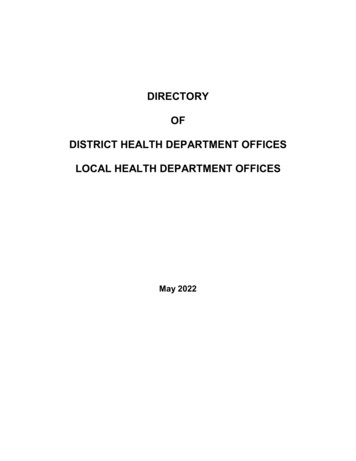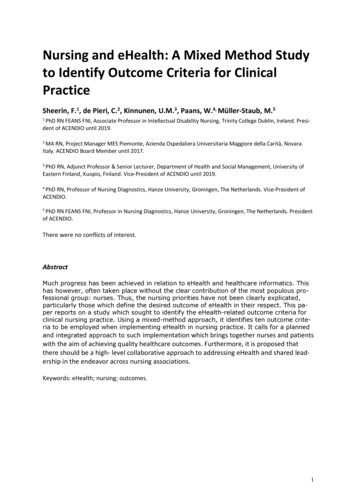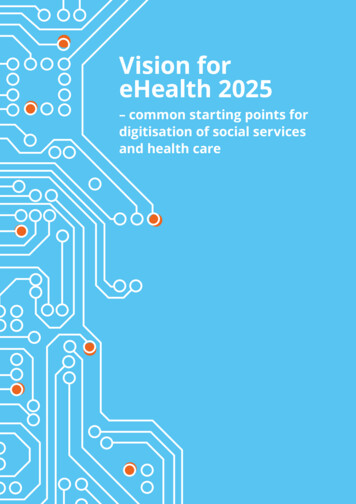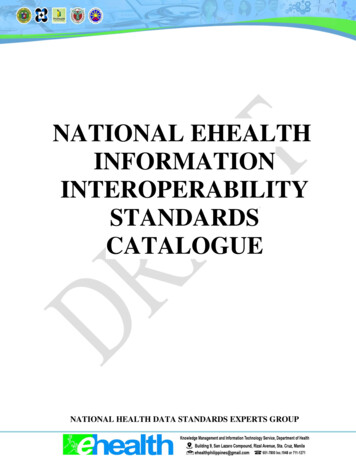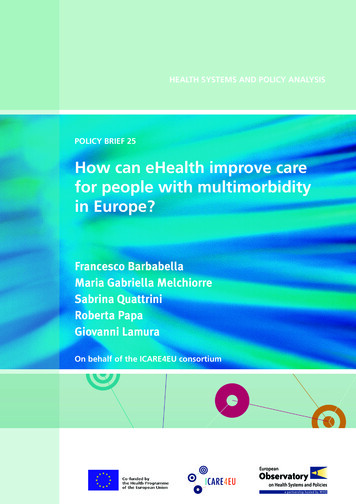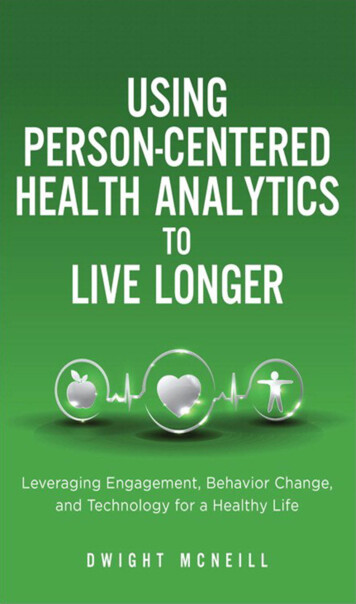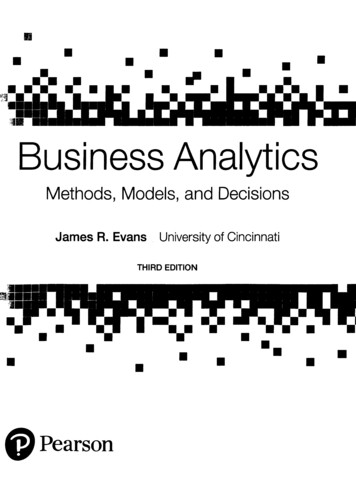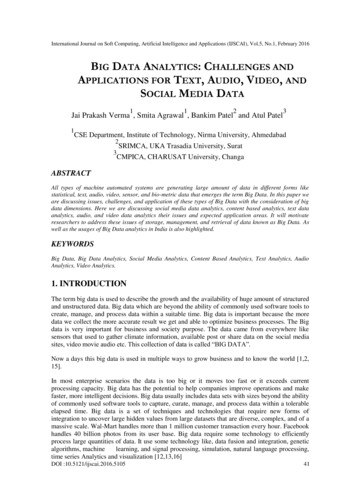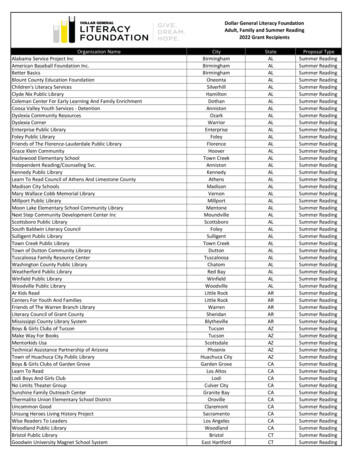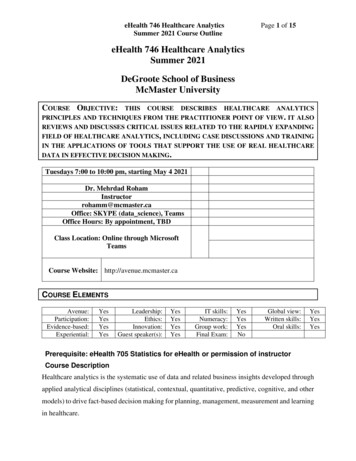
Transcription
eHealth 746 Healthcare AnalyticsSummer 2021 Course OutlinePage 1 of 15eHealth 746 Healthcare AnalyticsSummer 2021DeGroote School of BusinessMcMaster UniversityCOURSE OBJECTIVE:THIS COURSE DESCRIBES HEALTHCARE ANALYTICSPRINCIPLES AND TECHNIQUES FROM THE PRACTITIONER POINT OF VIEW. IT ALSOREVIEWS AND DISCUSSES CRITICAL ISSUES RELATED TO THE RAPIDLY EXPANDINGFIELD OF HEALTHCARE ANALYTICS, INCLUDING CASE DISCUSSIONS AND TRAININGIN THE APPLICATIONS OF TOOLS THAT SUPPORT THE USE OF REAL HEALTHCAREDATA IN EFFECTIVE DECISION MAKING.Tuesdays 7:00 to 10:00 pm, starting May 4 2021Dr. Mehrdad RohamInstructorrohamm@mcmaster.caOffice: SKYPE (data science), TeamsOffice Hours: By appointment, TBDClass Location: Online through MicrosoftTeamsCourse Website: http://avenue.mcmaster.caCOURSE est speaker(s):YesYesYesYesIT skills:Numeracy:Group work:Final Exam:YesYesYesNoGlobal view:Written skills:Oral skills:YesYesYesPrerequisite: eHealth 705 Statistics for eHealth or permission of instructorCourse DescriptionHealthcare analytics is the systematic use of data and related business insights developed throughapplied analytical disciplines (statistical, contextual, quantitative, predictive, cognitive, and othermodels) to drive fact-based decision making for planning, management, measurement and learningin healthcare.
eHealth 746 Healthcare AnalyticsSummer 2021 Course OutlinePage 2 of 15This course aligns with recent progress in analyzing healthcare databases for their knowledge ofvalue for healthcare operations, clinical decision support, and so on. Topics include the integrationof operational decision support through sharing of administrative and operational data, for multipleindependent healthcare providers and across different sectors of care. Students will get hands-onexperience with basic and advanced health analytics methods and techniques.The course will cover basics of raw data reading, data cleaning and management, data analysis,data mining, predictive analytics, social media analytics and data visualization. Students willundertake individual assignments and group projects to learn health analytic principles andtechniques: how to ask the right questions, manipulate real health data sets and create a dataproduct to communicate results and to show their analytical skills to potential employers. Studentsare encouraged to bring their laptops (preferably PCs) to class each day.LEARNING OUTCOMESUpon completion of this course, students will be able to complete the following key tasks: Explain the role that healthcare analytics can play in the analysis of data to assist in managerialdecision making for healthcare institutions and government agencies; Assess the prospects of healthcare analytics for playing a significant role in the descriptive,predictive and prescriptive processes in context dependent healthcare environments; Define the capabilities needed to successfully develop and deploy a feasible healthcareanalytics undertaking for institutional or government agency use; Formulate a plan and budget that considers how to modify an organization’s capabilities forimplementing a healthcare analytics undertaking; Understand how to implement data tools for gathering, cleaning, and updating data to be usedregularly or on an ad hoc basis to analyze, calculate or predict outcomes for use in decision making. Learn how to present, visualize and interpret findings. Design and develop dashboards for data storytelling.
eHealth 746 Healthcare AnalyticsSummer 2021 Course OutlinePage 3 of 15REQUIRED COURSE MATERIALS AND READINGSAvenue registration for course content, readings and case materials http://avenue.mcmaster.caText (library e-book): Strome, T. L. (2013). Healthcare analytics for quality andperformance improvement (e-book). Hoboken, New Jersey, Wiley.Online access to the McMaster Library to search for journal articles or booksrelevant to the topics being reviewed in the course.OPTIONAL COURSE MATERIALS AND READINGSBooks: Burke, J. (2013). Health Analytics. Gaining the Insights to Transform Health Care,Wiley.Reddy, C. K. and C. C. Aggarwal (2015). Healthcare Data Analytics (pdf Book). BocaRaton, Florida, CRC Press.Leiner, F., Gaus, W., Haux, R., & Knaup-Gregori, R.(2003). Medical DataManagement: A Practical Guide, Health Informatics Series.Siegel, Eric (2013). Predictive Analytics. The Power to Predict Who Will Click, Buy,Lie, Or Die, Wiley.Abbot, Dean (2014). Applied Predictive Analytics. Principles and Techniques for theProfessional Data Analyst, Wiley.Jones, Ben (20140. Communicating Data with Tableau, O'Reilly.Miller, James D. (2016). Learning IBM Watson Analytics. Make the most advancedpredictive analytical processes easy using Watson Analytics with this easy-to-followpractical guide, PACT Publishing.Hawley, David and Raina (2007). Excel Hacks, O'Reilly.Articles: Raghupathi, W. and V. Raghupathi (2014). "Big data analytics in healthcare: Promiseand potential." Health Inform Science & Systems 2(3): e10. Wang, Y., L. Kung and T. A. Byrd (2018). "Big data analytics: Understanding itscapabilities and potential benefits for healthcare organizations." TechnologicalForecasting & Social Change 126: 3-13.
eHealth 746 Healthcare AnalyticsSummer 2021 Course OutlinePage 4 of 15Online readings:5 trends in healthcare analytics for 2018Available at: yticsThe Healthcare Analytics Adoption Model.Available at: s-solutions/Healthcare Analytics insights.Available at: udent learning is through instructor presentations, discussions of cases relevant to specific topics,practices, assignments, student group presentations, and presentations by visiting speakers. Pleasesee pages 9-13 for more details. From the beginning of the term, students will be organized intogroups with a maximum number of three in each group. An attempt will be made to balancetechnical, healthcare, and business backgrounds and expertise among the members of each group.Discussion contributions from all students are expected in each class, particularly for the casesassigned for that day. Reference readings are provided for each class, but students should alsosearch for additional sources of material upon which to base their discussions. Each presentationwill be followed by a general class discussion of issues related to the topic, and students willreceive a mark based on their contribution to class discussions. Some sessions will be enriched byinvited speakers. Assignments are to be completed individually and submitted during the term inAvenue.Student groups will develop term projects on topics relevant to healthcare analytics and presentthem during the last week of the term. All team members must participate in presenting the projectand in preparing the written version of the project. This material is NOT to be regarded by eHealthstudents to be used for potential scholarly papers to meet eHealth program requirements. Term
eHealth 746 Healthcare AnalyticsSummer 2021 Course OutlinePage 5 of 15projects are to be decided after discussion and agreement with the instructor. The deadline fordeciding on group term projects is week five of the term, when an abstract of the proposed projecthas been approved by the instructor.The purpose of the group project is to demonstrate an ability to work as a team to read, collect,work with, clean, analyze and visualize a health data set/ or health datasets. The goal is to createan analytical data product (story, data dashboard(s)) to show the techniques and analytical skillslearned during the course.Your mark will depend on 4 major topics of analytics: datamanagement, statistical analysis, data mining and/or predictive analytics and visualization. Youwill be required to submit:1.1 A prepared data set for analysis.1.2 A syntax used for data preparation and for performing the analysis.1.3 A codebook that describes the variables, and any new variables/transformed variablesthat were used to clean up the data;2. Data product (using Tableau, Watson Analytics, or QlikSense):2.1 Interactive data for exploratory analysis.2.2. Modeling: at least 3 statistical tests.2.3. Modeling: at least 1-2 data mining methods and/or predictive analytics methods shouldbe used for analysis.Term project story should include title page, key findings, objective of analysis, findings,references, plus appendices as appropriate. All analyses should be visualized and interpreted.Exceptions to this list may be allowed if discussed beforehand with the instructor.Your final grade will be calculated as follows:
eHealth 746 Healthcare AnalyticsSummer 2021 Course OutlinePage 6 of 15Components and WeightsIndividual participation in class discussions20%Individual assignments (3-5)20%Group presentation on term project25%Written group term project report35%Total100%Grade ConversionAt the end of the course your overall percentage grade will be converted to your letter grade inaccordance with the following conversion scheme.LETTER GRADEA AAB BBFPERCENT90 - 10085 - 8980 - 8477 - 7974 - 7670 – 7300 - 69Communication and FeedbackStudents who are uncomfortable in directly approaching an instructor regarding a course concernmay send a confidential and anonymous email to the respective Area Chair or Associate irs.aspxStudents who wish to correspond with instructors or TAs directly via email must send messagesthat originate from their official McMaster University email account. This protects theconfidentiality and sensitivity of information as well as confirms the identity of the student. Emailsregarding course issues should NOT be sent to the Administrative Assistant.Instructors are encouraged to conduct an informal course review with students by Week #4 toallow time for modifications in curriculum delivery. Instructors should provide evaluationfeedback for at least 10% of the final grade to students prior to Week #8 in the term.
eHealth 746 Healthcare AnalyticsSummer 2021 Course OutlinePage 7 of 15ACADEMIC DISHONESTYIt is the student’s responsibility to understand what constitutes academic dishonesty. Please referto the University Senate Academic Integrity Policy at the following cStudies/AcademicIntegrity.pdfThis policy describes the responsibilities, procedures, and guidelines for students and facultyshould a case of academic dishonesty arise. Academic dishonesty is defined as to knowingly actor fail to act in a way that results or could result in unearned academic credit or advantage. Pleaserefer to the policy for a list of examples. The policy also provides faculty with procedures tofollow in cases of academic dishonesty as well as general guidelines for penalties. For furtherinformation related to the policy, please refer to the Office of Academic Integrity ism detected in written material may be reported to those responsible for overseeingacademic integrity. You may therefore wish to submit your written term paper to Turnitin.com orGrammarly to check for plagiarism before submitting it for marking. To see guidelines for the useof Turnitin.com or Grammarly, please go in/students/index.htmlor (for Grammarly) to: https://library.mcmaster.ca/news/8839Missed Mid-Term Examinations / Tests / Class ParticipationWhere students miss a regularly scheduled mid-term or class participation for legitimate reasonsas determined by the eHealth Office or MBA Academic Services Office, the weight for thattest/participation will be distributed across other evaluative components of the course at thediscretion of the instructor. Documentation explaining such an absence must be provided to theeHealth Office or MBA Academic Services Office within five (5) working days upon returning toschool.To document absences for health related reasons, please provide the Petition for Relief for MBAMissed Term Work and the McMaster University Student Health Certificate which can be ote.mcmaster.ca/forms-andapplications/. Please do not use the online McMaster Student Absence Form as this is forUndergraduate students only. University policy states that a student may submit a maximum ofthree (3) medical certificates per year after which the student must meet with the Director of theprogram.To document absences for reasons other than health related, please provide a Petition to the eHealthOffice or the Petition for Relief for MBA Missed Term Work and documentation supporting thereason for the absence.
eHealth 746 Healthcare AnalyticsSummer 2021 Course OutlinePage 8 of 15Students unable to write a mid-term at the posted exam time due to the following reasons: religious;work-related (for part-time students only); representing university at an academic or varsityathletic event; conflicts between two overlapping scheduled mid-term exams; or other extenuatingcircumstances, have the option of applying for special exam arrangements. Such requests must bemade to the MBA Academic Services Office or (for eHealth students) the eHealth Program Officeat least ten (10) working days before the scheduled exam along with acceptabledocumentation. Instructors cannot themselves allow students to unofficially write make-upexams/tests. Adjudication of the request must be handled by the MBA Academic Services Officeor eHealth Program Office.If a mid-term exam is missed without a valid reason, students will receive a grade of zero (0) forthat component.Missed Final Examinations/Team ProjectsA student who misses a final examination without good reason will receive a mark of 0 on theexamination.All applications for deferred and special examination arrangements must be made to the MBAAcademic Services Office or eHealth Program Office. Failure to meet the stated deadlines mayresult in the denial of these arrangements. Deferred examination privileges, if granted, must besatisfied during the examination period at the end of the following term. There will be one commonsitting for all deferred exams.Failure to write an approved deferred examination at the pre-scheduled time will result in a failurefor that examination, except in the case of exceptional circumstances where documentation hasbeen provided and approved. Upon approval, no credit will be given for the course, and thenotation N.C. (no credit) will be placed on the student’s transcript. Students receiving no creditfor a required course must repeat the course. Optional or elective courses for which no credit isgiven may be repeated or replaced with another course of equal credit value.Requests for a second deferral or rescheduling of a deferred examination will not be considered.Any student who is unable to write a final examination because of illness is required to submit theApplication for Deferred Final Examination and a statement from a doctor certifying illness on thedate of the examination. The Application for Deferred Final Examination and the McMasterUniversity Student Health Certificate can be found on the DeGroote website -applications/ Please do not use the onlineMcMaster Student Absence Form as this is for Undergraduate students only. Students who writeexaminations while ill will not be given special consideration after the fact.
eHealth 746 Healthcare AnalyticsSummer 2021 Course OutlinePage 9 of 15In such cases, the request for a deferred examination privilege must be made in writing to the MBAAcademic Services Office of eHealth Program Office within five business days of the missedexamination.Special examination arrangements may be made for students unable to write at the posted examtime due to compelling reasons (for example religious, or for part-time students only, work-relatedreasons): Students who have religious obligations which make it impossible to write examinationsat the times posted should consult the relevant policy at e students who have business commitments which make it impossible to writeexaminations at the times posted are required to produce a letter on company letterheadfrom the student’s immediate supervisor stating that they are unable to be present owing toa specific job commitment.In such cases, applications must be made in writing to the MBA Academic Services Office oreHealth Program Office at least ten business days before the scheduled examination date andacceptable documentation must be supplied.If a student is representing the University at an academic or athletic event and is available at anoverlapping scheduled time of the test/examination, the student may write the test/examination atan approved location with an approved invigilator, as determined by the MBA Academic ServicesOffice or eHealth Program Office.In such cases, the request for a deferred examination privilege must be made in writing to the MBAAcademic Services Office or eHealth Program Office within ten business days of the end of theexamination period.Note: A fee of 50 will be charged for a deferred exam written on campus and a fee of 100 fordeferred exams written elsewhere. In cases where the student’s standing is in doubt, the GraduateAdmissions and Study Committee may require that the student with one or more deferredexamination privileges refrain from re-registering until the examination(s) have been cleared.STUDENT ACCESSIBILITY SERVICESStudent Accessibility Services (SAS) offers various support services for students with disabilities.Students are required to inform SAS of accommodation needs for course work at the outset ofterm. Students must forward a copy of such SAS accommodation to the instructor normally, withinthe first three (3) weeks of classes by setting up an appointment with the instructor. If a studentwith a disability chooses NOT to take advantage of an SAS accommodation and chooses to sit fora regular exam, a petition for relief may not be filed after the examination is complete. The SASwebsite is:http://sas.mcmaster.ca
eHealth 746 Healthcare AnalyticsSummer 2021 Course OutlinePage 10 of 15POTENTIAL MODIFICATIONS TO THE COURSEThe instructor and university reserve the right to modify elements of the course during the term.The university may change the dates and deadlines for any or all courses in extreme circumstances.If either type of modification becomes necessary, reasonable notice and communication with thestudents will be given with explanation and the opportunity to comment on changes. It is theresponsibility of the student to check their McMaster email and course websites weekly during theterm and to note any changes.RESEARCH USING HUMAN SUBJECTSResearch involving human participants is premised on a fundamental moral commitment toadvancing human welfare, knowledge and understanding. As a research intensive institution,McMaster University shares this commitment in its promotion of responsible research. Thefundamental imperative of research involving human participation is respect for human dignityand well-being. To this end, the University endorses the ethical principles cited in the Tri-CouncilPolicy Statement: Ethical Conduct for Research Involving Humans:http://www.pre.ethics.gc.caMcMaster University has mandated its Research Ethics Boards to ensure that all researchinvestigations involving human participants are in compliance with the Tri-Council PolicyStatement. The University is committed, through its Research Ethics Boards, to assisting theresearch community in identifying and addressing ethical issues inherent in research, recognizingthat all members of the University share a commitment to maintaining the highest possiblestandards in research involving humans.If you are conducting original research, it is vital that you behave in an ethical manner. Forexample, everyone you speak to must be made aware of your reasons for eliciting their responsesand consent to providing information. Furthermore, you must ensure everyone understands thatparticipation is entirely voluntary. Please refer to the following website for more informationabout McMaster University’s research ethics zations that you are working with are likely to prefer that some information be treated asconfidential. Ensure that you clarify the status of all information that you receive from your client.You MUST respect this request and cannot present this information in class or communicate it inany form, nor can you discuss it outside your group. Furthermore, you must continue to respectthis confidentiality even after the course is over.If you plan to carry out research as part of this course that involves gathering and analyzingdata from human subjects, please discuss this with your instructor well in advance ofplanning and implementing your study.
eHealth 746 Healthcare AnalyticsSummer 2021 Course OutlinePage 11 of 15COURSE SCHEDULEeHealth 746 Healthcare AnalyticsSummer 2021 Course ScheduleWEEKDATEASSIGNMENTLecture/Presentation: 1.May 4 Overview of Health AnalyticsAdministrative, clinical, patient-reported andexternal data;Health Analytics ToolkitCommon representations of data in healthclassification systems (ICD-9 &10,CPT,CCI);Case Mix Group (CMG) classification;Personal Health Information Protection Act(PHIPA);Course data explanation CCHS, DAD files;Practice 1,2 : How to find ICD10, CCI codesin DAD documentation.SPSS introductionPractice 1.1-1.6Case 1: Class DiscussionWEEK’S ACTIVITIES &READINGS**Case 1 .ca/Group Formation (Max size 3;Mix of technical, healthcare,managerial skills as much aspossible)HIMSS Analytics roDatabases athttp://odesi1.scholarsportal.info/webview/
eHealth 746 Healthcare AnalyticsSummer 2021 Course OutlineLecture/Presentation: 2.May 11Reading raw data (.txt, .csv, Excel,etc.)Using master / standardized weights forsurvey dataData management basic tasks part 1: Creating new variables and recording, Data documenting Subsetting variables and observations, Data documented/codebook creation Practice 2.1-2.5Page 12 of 15Case 2 Lack of Healthcare ss.htmlWebinar: Clinical analytics inprimary carehttp://www.ask.com/youtube?q health analytics hsu summit&v uiCRc8is2A0&qsrc 472Case 2: Class DiscussionAssignment 1 (due week 3)3.May 18Lecture/Presentation:Data management basic tasks part.2: Sorting and splitting , Tips for cleaning data Missing values management Discovering missing patterns Missing data Imputation Practice 3.1-3.3Case3 Big DataImprovesIntroductionto SPSS;ComparisonCardiology Diagnoses by 17%with data-improvescardiology-diagnoses-by-17/Assignment 2 (due week 4)Case 3: Class DiscussionLecture/Presentation:4.May 25Data management advanced tasks: Collapsing data across observations1Concatenating files (Adding cases) Merging files Reshaping from long format to wide format Reshaping from wide format to long format Practice 4.1-4.5 Knowing your data: data audit summaryRecommendations for appropriate datatransformation Cleaning techniques Binning Scaling and normalization methods Practice 4.3.1-4.3.2Class DiscussionFinalize decisions on group termproject choices
eHealth 746 Healthcare AnalyticsSummer 2021 Course Outline5.6.7.June 1June 8June 15Lecture/PresentationUsing Simple Statistics for Data Understanding: EDA Frequencies, Descriptive Stat, QQ-plots Transformations, Normalization Association between two variables Practice 5.1-5.8Class DiscussionLecture/PresentationPredictive analytics: Multiple regression: simultaneous andhierarchical How to interpret the regression results? Automatic linear modeling Difference between standardmodel, boosting and bagging Interpretation and visualization ofregression modeling results Logistic regression Confusion matrix and performance metrics:sensitivity, specificity, accuracy, etc. Roc curve ML Methods: NN, Random Forest, NaïveBayes,etc Practice 6.1-6.4Case 4: Class DiscussionLecture/PresentationData mining (DM) methods Part 1: What is data mining? Origins of DM. Data mining versus statistical analysis Association rules (AR) modeling AR terminology AR results visualization Practice AR modelingCase 5: Class DiscussionPage 13 of 15Assignment 3 (due week 6)Case 4. Use Cases for cs-big-dataCase 5 Applying Data Mining toHealthcare Data /788/applying data miningto software development projects a case study.pdf
eHealth 746 Healthcare AnalyticsSummer 2021 Course OutlinePage 14 of 15Lecture/Presentation8.June 22Data mining (DM) methods Part 2: Unsupervisedlearning (clustering) What to look at when clustering Algorithm for k-means clusteringin Excel How to determine optimal numberof clusters in k-means clustering Interpreting the clustering results Cluster evaluation Cluster visualization Two-step clustering Cluster prototypes andinterpretation Practice clusteringClass DiscussionLecture/Presentation9.June 29Data mining (DM) methods Part 3: Decision trees(DTs) and model scoring Main tasks for DT predictive analytics How to interpret the results Misclassification costs PMML – Predictive model markup language Scoring/Deploying predictive models DT scoring example Practice DT modelingClass DiscussionLab Session10.July 6StoryTelling with Tableau Part1: Introduction to Tableau Connecting data User Interface (UI) overview Basic charts Formatting basics Maps intro Practice 10Class DiscussionAssignment 4 (due week 8)
eHealth 746 Healthcare AnalyticsSummer 2021 Course OutlinePage 15 of 15Lab Session11.July 13Storytelling with Tableau part 2: Creating dashboards Telling a story Advanced charts Using Advanced Analytics: calculation,totals, correlation, regression, clustering How to visualize your results from stat tests,DMs? Practice 11Class DiscussionLab Session 12.July 2113.July 27Developing and deploying analyticalproduct for institutional or governmentagency useHow to develop a plan and budget forimplementing a healthcare analyticsundertaking: Why create an analysis plan? What does an analysis plan include? Developing a Health AnalyticsRoadmapInstructor and/or TA availableduring class hours or office hoursGroup Project PresentationsTerm Project DiscussionClass Discussions**Class Schedule and ResourcesThe class will be organized into teams during the second class, with a maximum of three membersper team. An attempt will be made to balance expertise so that there is technical, health, andmanagerial/business background represented in each team. A case will be provided each weekthat is relevant to the topic of the week, and students are expected to come to class prepared todiscuss the case.Class members will all be expected to become familiar with the SPSS and Tableau softwarepackages and demonstrate their expertise by applying the software to assignments where relevant.All practices, examples and visualizations are provided with real health data.Students are expected to attend lab sessions that will mostly involve planning and developing thegroup projects (class sessions 9 through 12). This will give an opportunity to interact with otherteam or class members, or to discuss issues with the instructor or tutorial assistant, who will alsobe available during office hours for consultations.
Applied Predictive Analytics. Principles and Techniques for the Professional Data Analyst, Wiley. Jones, Ben (20140. Communicating Data with Tableau, O'Reilly. Miller, James D. (2016). Learning IBM Watson Analytics. Make the most advanced predictive analytical processes easy using Watson Analytics with this easy-to-follow
